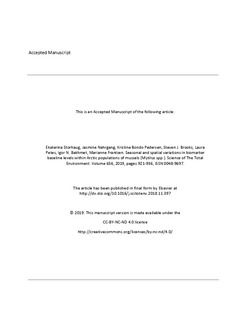| dc.contributor.author | Storhaug, Ekaterina | |
| dc.contributor.author | Nahrgang, Jasmine | |
| dc.contributor.author | Pedersen, Kristine Bondo | |
| dc.contributor.author | Brooks, Steven | |
| dc.contributor.author | Petes, Laura | |
| dc.contributor.author | Bakhmet, Igor N. | |
| dc.contributor.author | Frantzen, Marianne | |
| dc.date.accessioned | 2019-11-21T07:13:53Z | |
| dc.date.available | 2019-11-21T07:13:53Z | |
| dc.date.created | 2019-04-07T14:53:30Z | |
| dc.date.issued | 2019 | |
| dc.identifier.citation | Science of the Total Environment. 2019, 656, 921-936. | nb_NO |
| dc.identifier.issn | 0048-9697 | |
| dc.identifier.uri | http://hdl.handle.net/11250/2629608 | |
| dc.description | Embargo until 28 November 2020 | nb_NO |
| dc.description.abstract | Climate change and pollution resulting from human activities in the Arctic require reliable monitoring systems in sentinel species. Mytilus spp. are used as sentinel species all around the world. The use of Mytilus spp. in environmental monitoring requires knowledge about natural variations in pollution biomarkers. Seasonal variations in baseline levels of biomarkers were studied over a year in the mussels from both upper and lower littoral zones in Rakkfjorden, Norway, as they underwent their annual reproductive cycle. Spatial variations of these biomarker baseline levels were measured in five mussel populations within a 60-km radius from Rakkfjorden to investigate universality of the results from the specific population of Rakkfjorden at a regional scale. Seasonal variations in biomarker baseline levels were revealed and seemed to be related to the reproductive state of the mussels and the tidal zone. The mussels appeared to be more sensitive to oxidative stress during gametogenesis in autumn and winter, when having lower lysosome membrane stability and lower baseline levels of antioxidant biomarkers. An increase in baseline levels of these biomarkers was reported during spawning in spring, however, it was not possible to reveal whether these changes were due to spawning, or to a higher metabolic activity in mussels in response to elevated water temperature and food abundance. The differences between the tidal zones were reflected in reduced size of the mussels from the upper littoral zone, their late spawning in the season and increased baseline levels of antioxidant biomarkers during the coldest month, indicating a more challenging environment in the upper littoral zone. The spatial study indicated that the biomarker baseline levels measured in Rakkfjorden were no different from the levels measured in the mussels from five other sites and thus, are representative for mussels on a regional scale. | nb_NO |
| dc.language.iso | eng | nb_NO |
| dc.publisher | Elsevier | nb_NO |
| dc.rights | Attribution-NonCommercial-NoDerivatives 4.0 Internasjonal | * |
| dc.rights.uri | http://creativecommons.org/licenses/by-nc-nd/4.0/deed.no | * |
| dc.title | Seasonal and spatial variations in biomarker baseline levels within Arctic populations of mussels (Mytilus spp.) | nb_NO |
| dc.type | Journal article | nb_NO |
| dc.type | Peer reviewed | nb_NO |
| dc.description.version | acceptedVersion | nb_NO |
| dc.source.pagenumber | 921-936 | nb_NO |
| dc.source.volume | 656 | nb_NO |
| dc.source.journal | Science of the Total Environment | nb_NO |
| dc.identifier.doi | 10.1016/j.scitotenv.2018.11.397 | |
| dc.identifier.cristin | 1690673 | |
| dc.relation.project | Andre: Russian Foundation for Basic Research 12-04-93081-Norv_a | nb_NO |
| dc.relation.project | Norges forskningsråd: 225044 | nb_NO |
| cristin.unitcode | 7464,20,13,0 | |
| cristin.unitname | Økotoksikologi | |
| cristin.ispublished | true | |
| cristin.fulltext | postprint | |
| cristin.qualitycode | 2 | |

